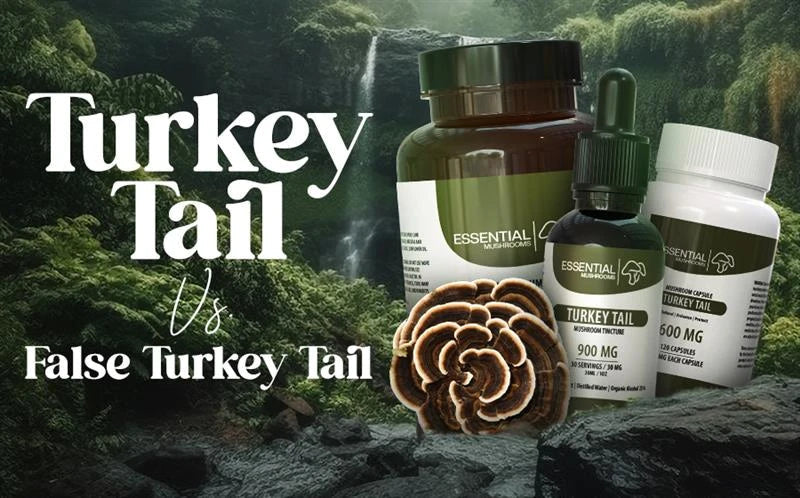Trametes versicolor, or Turkey Tail mushroom, is one of the most demanded mushrooms on the market. Known for its immunomodulatory properties, which put it on the list of functional mushrooms, Turkey Tail has a feather-like, colorful appearance that almost resembles a turkey’s tail (hence, the name) and should be easily identifiable; however, this is not the case. Some look-alikes (like the stereum ostrea) have infiltrated the mushroom market, and learning to differentiate between the original and the false will determine your experience.
A Quick Overview of Turkey Tail Mushrooms
Turkey Tail has made a name for itself with its healing abilities. For centuries, it has been used in traditional Chinese medicine. Today, it has become a popular wellness supplement, available as Turkey Tail mushroom gummies, capsules, tinctures, and other products.
Many premium Turkey Tail products are made from indoor-grown medicinal mushrooms, but some are harvested directly from the wild. This fungus grows predominantly in Asia, Europe, and North America. Its colors and rounded exterior make it easy to identify. However, spotting the real ones can be tricky since false Turkey Tail exists.
Common Lookalikes of Turkey Tail
● Stereum ostrea
This mushroom has bands of color like Turkey Tail mushrooms but with a darker red color. Checking the pores on their underside shows the difference, as you will notice Stereum ostrea does not have any. It has a large 5-centimeter cap, and its leathery texture makes it inedible.
● Trichaptum abietinum
It has a grey or white color that blends with a violet hue, which gives it the name violet-toothed polypore. Its underside has pores that resemble teeth, both in pattern and structure. This inedible mushroom grows up to four centimeters on dead conifer wood.
● Trametes betulina
Trametes betulina, also known as multicolor gill polypore, gets its name from the colorful concentric zones and gill-like underside. It is larger than the others and can grow up to 10 centimeters on rotting wood and dead deciduous trees. It has hairs on its caps, and its tough, leathery gills make it inedible.
Identifying the Difference Between Turkey Tail and False Turkey Tail Mushrooms
A regular user may wonder—why go through all the trouble when you can easily access the best Turkey Tail supplement? At Essential Mushrooms, we believe that learning something new never gets old. Understanding the differences between real and fake mushrooms will give you a better idea about what you’re having.
There are multiple differences between Turkey Tail and false Turkey Tail. To identify the beneficial ones, look for these characteristics:
● Color: Start with color, which, on a real Turkey Tail mushroom, generally ranges from white and brown to blue and gray. False Turkey Tails often have a more muted or uniform color palette, sometimes leaning towards dull reds, yellows, and oranges.
● Underside: The most crucial distinguishing factor is the underside of the mushroom. Turkey Tail mushrooms have a porous underside with tiny, closely packed pores. False Turkey Tail mushrooms, like Stereum ostrea, have a smooth or slightly wrinkled underside without pores. Trichaptum abietinum, on the other hand, has a toothed underside rather than pores.
● Texture: Turkey Tail mushrooms have a challenging and leathery texture, which allows them to be dried and ground into powders or extracted into supplements. False Turkey Tails, particularly Stereum ostrea, feel thinner and more papery, making them less durable.
● Growth Habitat: While both Turkey Tail and its lookalikes grow on deadwood, knowing the specific host tree can help with identification. Turkey Tail mushrooms are commonly found on hardwoods such as oak and maple. False Turkey Tails like Trichaptum abietinum often prefer coniferous wood.
Health Benefits of Turkey Tail Mushrooms
Real Turkey Tail mushrooms contain polysaccharopeptides, including PSP (Polysaccharide Peptide) and PSK (Polysaccharide-K), which contribute to immune system support. They are rich in antioxidants and prebiotics, making them a sought-after choice for overall gut and immune health. Unlike false Turkey Tails, which lack these beneficial compounds, genuine Turkey Tail mushrooms provide a valuable boost to wellness.
Why Identifying the Right Mushroom Matters
Identifying real Turkey Tail mushrooms ensures you get the full range of health benefits associated with this powerful functional mushroom. False Turkey Tails may not be harmful, but they do not offer the same medicinal properties. To make sure you're consuming the right mushroom, opt for the best Turkey Tail mushroom capsules from trusted sources like Essential Mushrooms.
Final Thoughts
Distinguishing between Turkey Tail and false Turkey Tail mushrooms is essential for anyone interested in the medicinal benefits of fungi. By paying attention to characteristics like color, pore structure, texture, and habitat, you can confidently identify and select the real deal. At Essential Mushrooms, we are committed to providing top-quality Turkey Tail mushroom products to support your wellness journey.
For the best Turkey Tail supplements, visit Essential Mushrooms today and experience the benefits of nature’s immune-boosting powerhouse!
Also Read: What Does Lion's Mane Mushroom Taste Like?
- View: 86
- Categories: News

